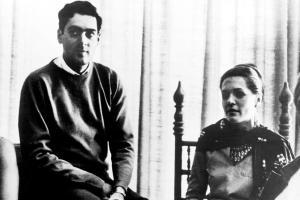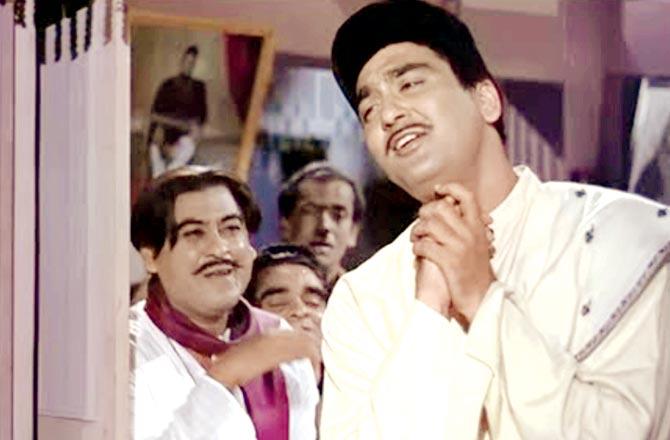A 50th birthday triggers thoughts on people and institutions that resonated in the year 1968

Rajiv Gandhi and his then, fiancu00c3u0083u00c2u0083u00c3u0082u00c2u00a9e Sonia Maino prior to their wedding, on February 26, 1968 in New Delhi. Pic/Getty Images
 When the official mid-life mark — turning 50 years old — approaches, it signifies a vague miscellany. In my personal space, it signalled a readiness for a calcium prescription, reading glasses and a savvier handling of savings. It was also a time for a strange recollection of known, but unrelated people born five decades ago — weightlifter Kunjarani Devi, jailed gangster Abu Salem, Hollywood wonder Will Smith, Munnabhai-starrer Arshad Warsi, and closer home, Maharashtra Navnirman Sena leader Raj Thackeray, whose brush will now bring to life PL Deshpande's pen portraits.
When the official mid-life mark — turning 50 years old — approaches, it signifies a vague miscellany. In my personal space, it signalled a readiness for a calcium prescription, reading glasses and a savvier handling of savings. It was also a time for a strange recollection of known, but unrelated people born five decades ago — weightlifter Kunjarani Devi, jailed gangster Abu Salem, Hollywood wonder Will Smith, Munnabhai-starrer Arshad Warsi, and closer home, Maharashtra Navnirman Sena leader Raj Thackeray, whose brush will now bring to life PL Deshpande's pen portraits.
As my chronological benchmark stands hours away, 1968 becomes more than a year — a symbol of institutions and constructs that stayed afloat — somewhat like the Public Provident Fund tax-saving scheme that has safeguarded millions of lower and middle class salaried Indians. Introduced by the National Savings Institute of the Ministry of Finance in 1968, its raison d'être of small savings still fits well in the 2018 frame of reference; unlike hotel keys, landline telephones and cursive writing pride, which are turning obsolete in Shining India.
ADVERTISEMENT
In the global context, 1968 was the International Human Rights Year; starting with the unfortunate April assassination of civil rights leader Martin Luther King Jr; May was marked by general strikes and student occupations in France, overlapping with trade union protests across central and eastern Europe. In India, the first female Prime Minister Indira Gandhi was a much-loved and much-hated formidable leader of the Congress party, the face of a 20-year-old non-aligned republic. In 1968, she was (for the second time) the most admired woman in a poll conducted by the French Institute of Public Opinion. She had many challengers, some in her own party, who soon disqualified her from the 'original' Congress.

Padosan, which released in November 1968, was a reflection of the distinct cultural components that made a vibrant hi-energy India
One of her vocal opponents was Atal Bihari Vajpayee, who became the president of the Bharatiya Jana Sangh in 1968, a party projecting itself as an alternative to the Congress. Exactly 50 years later, Indira Gandhi is no more; her party sits on the Opposition benches; 93-year-old Vajpayee lies in a hospital; the BJP, which he headed for long, is the world's largest party in terms of primary membership. Incidentally, Sonia Gandhi, the longest-serving (former) president of the Congress party, an Italian by descent, married into the Gandhi family in the year 1968. That was also the year when India sent Jane Coelho, the first-ever winner of the Bharat Sundari contest, for the Miss World beauty pageant. In the February of that year, the Beatles rock band was hosted in Rishikesh by Maharishi Mahesh Yogi in a transcendental meditation workshop. The 1969 Utpal Dutt starring film The Guru was inspired by Beatles' guitarist George Harrison's embrace of Indian spirituality and music.
Harrison's song Inner Light was recorded in a Mumbai studio in 1968, first time with accompanying Indian instruments. The Hindi film universe blossomed in 1968, as evident in the mixed flavours offered by the 75-odd releases, of which some enriched the popular discourse, not just added shades to the mainstream Bollywood space. For instance, Padosan is not a mere comedy revolving around two naughty lovers, but a reflection of the distinct cultural components that made a vibrant hi-energy India. South Indian music teacher Master Pillai (played by Mehmood) pitted against the Bengali mentor-folk theatre practitioner Vidyapati (essayed by singer-actor Kishore Kumar) tops any cablewala's first choice. Proudly stereotypical, Padosan evokes empathy — its musical repartee Ek Chatur Naar Karke Singar unparalleled till date. Among the other films of the year that shaped the Indian consciousness were Bramhachari (a do-gooder orphan gives shelter to his kind), Kanyadaan (denouncing child marriages) and Juari (youth takes to gambling only to realise the sparkle of honesty), which also epitomised the pre-Emergency idealism and innocence!
The most profitable film of the year was India's first Hindi spy thriller Ankhen, the immensely popular Dharmendra starrer known for the hugely hummable Milti Hain Zindagi Mein Mohabbat Kabhi Kabhi. Ankhen introduced us to a far-off Beirut, where abductions and murders besiege an odd set of Indians, who break into jigs (De Daata Ke Naam Tujhko Allah Rakhe) as a mode of rescue. It is a funny coincidence that India's specialised agency dedicated to foreign intelligence gathering was established in the same year.
The Research and Analysis Wing, which was initially supposed to be a wing of the main Intelligence Bureau, was shaped into an exclusive high-power entity by the legendary spymaster Rameshwarnath Kao. Among the trusted security advisors of PM Gandhi, he adhered to her idea of a strong sovereign strategically-alert country, which thrived on key insights whenever she went to war or was hit by a terror attack. Kao laid the foundation of modern and professional intelligence handling. In the year when RAW turns 50, the Bollywood spy film Raazi features an Indian mole, who married a Pakistani military officer, a little before the 1971 war, in order to spot information of a possible attack on an Indian aircraft carrier. The mole was trained for the job by RAW, onscreen and in real life.
The year was characterised by the first National Policy on Education in 1968, which aimed at equalising educational opportunities in order to integrate India. The policy outlined a well-meaning trisutra — so that students learn English along with the official language of the state and Hindi too. That year, both Houses of the Parliament, declared it "the duty of the Union to develop Hindi as a medium of expression for all the elements of the composite culture of India." As a student of Kendriya Vidyalaya, in places as diverse as Port Blair, Shillong, Gwalior, Itanagar and Mumbai, I have seen Hindi serving as a magic organic link between students from multi-hued states. As a journalist covering culture since 1988, I have seen the lack of acceptance of Hindi and English in many states like contemporary Maharashtra, where language hatred is not a matter of shame; it is a legitimate tool to win an election. To be 50, is to realise that both are realities and language politics makes an evergreen beat if you reside in a city that has several tongues.
Sumedha Raikar-Mhatre is a culture columnist in search of the sub-text, you can reach her on sumedha.raikar@gmail.com
Catch up on all the latest Crime, National, International and Hatke news here. Also download the new mid-day Android and iOS apps to get latest updates
 Subscribe today by clicking the link and stay updated with the latest news!" Click here!
Subscribe today by clicking the link and stay updated with the latest news!" Click here!







